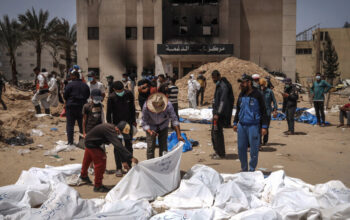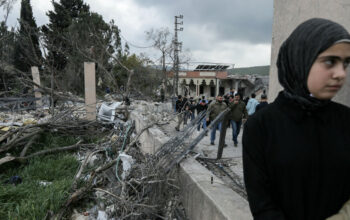
Avril Haines, the U.S. director of national intelligence, recently outlined three plausible scenarios in Ukraine.
In the first, Russia’s continuing progress in eastern Ukraine would break Ukrainians’ will to fight and allow the Russian military to take over even more of the country. This outcome is Vladimir Putin’s new goal after being defeated in his initial attempt to oust Ukraine’s government.
In the second scenario — the most likely one, Haines said (during a public appearance in Washington last week) — Russia would dominate the east but would not be able to go much farther. The two countries would fall into a stalemate that Haines described as “a grinding struggle.”
In the third scenario, Ukraine would halt Russia’s advance in the east and also succeed in launching counterattacks. Ukraine has already regained some territory, especially in the southern part of the country, and some military experts expect a broader offensive soon.
Today’s newsletter provides an update on the war by examining a few questions that will help determine which of these three scenarios becomes most likely.
Temporary or permanent
Has the tide definitively turned or are Ukrainian forces about to have more success?
The most recent phase of the war has gone well for Russia. The eastern part of Ukraine, known as the Donbas region, has two provinces — Luhansk and Donetsk. Russia now controls virtually all of Luhansk and about 60 percent of Donetsk, according to Thomas Bullock, an analyst for Janes, a company specializing in intelligence issues.
Yesterday, Russian forces increased their shelling near Bakhmut, a city in Donetsk that’s an important Ukrainian supply hub. Russia used a similar tactic in Luhansk to clear Ukrainian forces and civilians before taking over cities.
“The Kremlin is sending the message that their overall plans haven’t changed and that everything is going according to plan,” Anton Troianovski, The Times’s Moscow bureau chief, said. In a sign of confidence in the Kremlin, Russian media have recently been reporting plans for holding referendums in the captured territories and formally annexing them, Anton added.
But Ukraine does continue to benefit from an influx of sophisticated weapons from the West. And there is some reason to wonder whether Ukrainian troops will soon be able to make better use of those weapons than they have so far.
In the initial phase of the war, the U.S., E.U. and other Ukrainian allies were sending relatively simple weapons, like the shoulder-fired missile systems known as Javelins. Those weapons helped Ukraine defend territory from small groups of Russian forces. More recently, the West has sent more powerful artillery — like the HIMARS, a truck-based rocket system — meant to help Ukraine withstand the massive buildup of Russian troops in the east.
Training somebody to use a Javelin can take just a few hours, my colleague Julian Barnes points out. Training troops to use a HIMARS can take days or weeks — as does transporting them to the battlefield. In coming weeks, Julian said he would be watching to see whether Ukraine would be able to use its growing supply of HIMARS to inflict more damage on Russian troops.
(Here’s more on the early effect of the HIMARS from Eric Schmitt and John Ismay of The Times.)
No Russian draft
Is Russia running out of troops?
Two recent developments have offered reason to wonder. First, Russia has had to turn to outside troops — like those from the Wagner Group, a private company — to replenish their units, as my colleague Thomas Gibbons-Neff explained in his recent analysis of the war. Second, Putin ordered some of the troops involved in recent victories in the Donbas region to rest, suggesting that those units were exhausted.
“American officials and outside analysts both agree if Russia wants to move beyond the Donbas, they will need to take a step they have been unwilling to do: a mass mobilization,” Julian said. “Russia will need to conduct a military draft, recall soldiers who previously served and take politically painful steps to rebuild their force. So far, Putin has been unwilling to do so.”
Russia has many more resources than Ukraine, including soldiers and weapons. But Russia’s resources do have limits, especially if Putin is unwilling to spend political capital on a mass mobilization.
These limits raise the prospect that Ukraine can hold Russia’s gains to the east and slowly exhaust Russian troops with counterattacks and internal resistance — as well as Western economic sanctions. That situation, in turn, could lead Putin to accept an eventual cease-fire that leaves most of Ukraine intact.
“That will not be a perfect victory,” Julian said, “but it might be realistic.”
Shell shock
But is Ukraine running out of troops even faster?
Both sides appear to be suffering a similarly high rate of casualties — hundreds per day. As a result, Ukraine has had to rely increasingly on troops with little training.
The surviving troops are also at risk of psychological damage. The method of fighting in the east — an unceasing exchange of artillery — resembles the trench warfare of World War I, which gave rise to the term “shell shock,” my colleague Thomas notes.
“During the artillery shelling, all you can do is lay in the shelter and wait for the shelling to end,” one Ukrainian commander told The Times. “Some people get mentally damaged because of such shelling. They are found to be psychologically not ready for whatever they encounter.”
As uncertain as the future may be in Ukraine, the present is clearly dire, as Haines acknowledged when outlining the three scenarios last week. “In short,” she said, “the picture remains pretty grim.”
Related commentary: “The best way to prevent the next war is to defeat him in this one,” The Economist magazine writes, referring to Putin.
THE LATEST NEWS
Gun violence
Claddagh ring: This piece of jewelry has come to symbolize Ireland.
A Times classic: Who’s hacking your Spotify?
Advice from Wirecutter: Mattresses to reduce back pain.
Lives Lived: Kurt Markus’s black-and-white photographs captured the solitude and grandeur of the American West’s vanishing frontier. He died at 75.
SPORTS NEWS FROM THE ATHLETIC
A programming note: This new sports section is written by the staff of The Athletic.
The future of college football on TV: With U.S.C. and U.C.L.A. set to join the Big Ten conference, a question lingers: Is college football headed for a Premier League setup? It’s possible. Here is how college football (on TV) is set to change forever.
Recruiting in Senegal, via Instagram: College football programs are intrigued by a 6-foot-5, 300-pound athlete from Senegal. He’s never played football. And there’s this: Can he even make it to the U.S.?
The next big name in N.F.L. coaching searches: Meet 36-year-old Thomas Brown, Sean McVay’s next man up for the Los Angeles Rams.
For access to all Athletic articles, subscribe to New York Times All Access or Home Delivery.
ARTS AND IDEAS
Fashion’s shock factor
Clothing used to have the ability to jolt viewers with concepts that today feel quaint, like a flash of flesh or an absurd idea. At this summer’s Paris couture shows, fashion houses have attempted to prove that their industry still has the ability to shock.
One effort has stood out, writes Vanessa Friedman, The Times’s chief fashion critic: Iris van Herpen, whose use of 3-D printers and laser cutters make her clothes look like organic life-forms. “They rewrite the physics of dress and reimagine the body without erasing it, not in a cartoonish way but in an utterly convincing way,” Vanessa writes.



